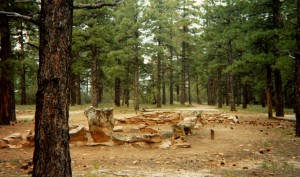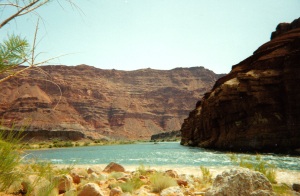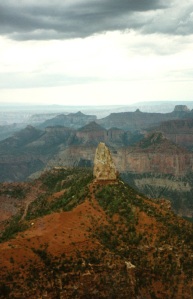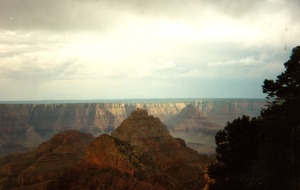TOPIC G: The Grand Canyon Is. . . Well, GRAND
 I first visited the Grand Canyon over 25 years ago. I hoped it would be as marvelous as I expected. I was not disappointed. No wonder Theodore Roosevelt said, “It is the one great wonder. . . every American should see.” It is a phenomenal awe-inspiring place. Since then, I have been back many times—sometimes by myself, other times with friends. I already talked about a couple of my favorite visits in an earlier post. But the Grand Canyon deserves a fuller review.
I first visited the Grand Canyon over 25 years ago. I hoped it would be as marvelous as I expected. I was not disappointed. No wonder Theodore Roosevelt said, “It is the one great wonder. . . every American should see.” It is a phenomenal awe-inspiring place. Since then, I have been back many times—sometimes by myself, other times with friends. I already talked about a couple of my favorite visits in an earlier post. But the Grand Canyon deserves a fuller review.
Some Details:
If you have not yet seen the Grand Canyon, you might wonder what the big deal is. After all, it is basically just a big hole in the ground. In fact, in the early 1800s, Lt. Joseph Ives led an army survey party into the canyon and concluded it was “altogether valueless.” I would argue with him! The details of its size, variety and geography are impressive, even if you never see the place:
- Located in Arizona, the Grand Canyon is a mile deep and close to 18 miles wide.
- In total, this national park covers over 1,900 square miles—that is roughly 1.2 million acres.
- The canyon is 277 miles long, so long that no vantage point offers a view of the entire expanse.
- Still, on a good day in terms of air quality—most days!—visibility averages 90 to 110 miles.
- The Colorado River runs through the canyon as the primary agent that cut this gorgeous gorge into existence.
- The rocks at the bottom of the canyon are roughly 1.8 billion years old, but most geologists agree the gorge was created by erosion over the last 5 million years.
- Visitors can access the canyon from both the South Rim and the North Rim, but each side varies in its vegetation, animals, weather and elevation.
- Over 1,500 plant, 355 bird, 89 mammalian, 47 reptile, 9 amphibian, and 17 fish species are found in the park.
This gorge offers spectacular colors and formations, awe-inspiring vistas, and wondrous evidence of geological actions at work. Is it any wonder that John Muir offered the following conclusion when he visited the Grand Canyon? “No matter how far you have wandered hitherto, or how many famous gorges and valleys you have seen, this one, the Grand Canyon of the Colorados, will seem as novel to you, as unearthly in the color and grandeur and quantity of its architecture, as if you had found it after death, on some other star…”
Some History:
The massive area today called the Grand Canyon has been and still is home to native cultures. Archaeological studies confirm that the oldest human artifacts in the area date back 12,000 years. The area has been in continuous use since then, inhabited by a range of tribes including Paleo-Indian, Ancestral Puebloan, Cohonina, Southern Paiute, Zuni, Hopi, and Navajo. Some lived in the area while others visited annually for what seems to be religious reasons. The Cohonina were ancestors of the Yuman, Havasupai, and Haulapai peoples who inhabit the area today.
To get an overview of the archaeological findings throughout the canyon, visit this link and scroll down a bit to find the national park service video titled “Archaeology Along the Colorado River.” Fortunately, some archaeological finds are available for public viewing. Ruins are visible on both the North and South Rims, showing sites where some native peoples once lived. On the North Rim, the Walhalla Glades Pueblo Ruins show remnants of buildings left from over 900 years ago. This site was a summer home for families for over 100 years. On the South Rim, the ruins are an old Pueblo Indian site that was occupied for about 20 years around 1185. The area is called the Tusayan Ruins and includes a small museum open to the public.
 The Walhalla Glades Pueblo Ruins (North Rim):
The Walhalla Glades Pueblo Ruins (North Rim):
 The Tusayan Ruins (South Rim):
The Tusayan Ruins (South Rim):
 The Tusayan Museum exhibits a full range of artifacts found throughout the area. For me, the split-twig figurines typically crafted from single willow twigs that are folded into animal shapes are the most intriguing. They were found in remote caves, dating from 2,000 to 4,000 year ago. Extensive pottery holdings are on exhibit as well, showing full vessels as well as broken remnants. These exhibits make a tangible link between visitors of today and the inhabitants from so many years ago. For me, the puzzle is engaging, whether pieces of the past or pieces of a broken pot are being put together.
The Tusayan Museum exhibits a full range of artifacts found throughout the area. For me, the split-twig figurines typically crafted from single willow twigs that are folded into animal shapes are the most intriguing. They were found in remote caves, dating from 2,000 to 4,000 year ago. Extensive pottery holdings are on exhibit as well, showing full vessels as well as broken remnants. These exhibits make a tangible link between visitors of today and the inhabitants from so many years ago. For me, the puzzle is engaging, whether pieces of the past or pieces of a broken pot are being put together.
Early Visitors:
Sent by Coronado in 1540 to search for the fabled seven cities of gold, Captain Garcia Lopez de Cardenas led a group into the canyon with the aid of Hopi guides and became the first non-Native visitor to see the canyon. More than 200 years passed before two Spanish priests led another non-Native expedition into the canyon. Most of the activity even then focused on access via the South Rim. In 1776 Father Escalante became the first European to visit the North Rim. Over the next hundred years, other groups—often hunters, trappers, and miners—made short targeted trips into the canyon.
John Wesley Powell led his first expedition along the Green and Colorado Rivers through the canyon in 1869. Although others had visited the area before, Powell’s expedition was the first to traverse the entire canyon. After this trip, he began publishing the term “Grand Canyon” to refer to the area, and the name has stuck. In his journals, he was rather literal when he explained that “wherever we looked was a wilderness of rocks,” but he also added that this impressive chasm was “the most sublime spectacle on earth.”
In the early 1900s, President Theodore Roosevelt was enamored of the area, frequently hunting along both the north and south sides of the canyon. Given his concern for conservation, he initially named the Grand Canyon a Game Preserve and then upgraded it to National Monument status in 1908. Those wishing to use the land especially for its mining and marketing potential opposed any further conservation efforts for many years. Finally, in 1919, President Woodrow Wilson signed the papers making The Grand Canyon part of the recently formed national park service. During that first year as a national park, roughly 44,000 visitors enjoyed its beauty and grandeur.
Visitors Today:
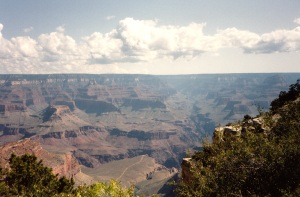 Today, nearly 5 million visitors enjoy the Grand Canyon each year. I suppose some are like the Griswolds in National Lampoon’s Vacation: Looking out over the rim for maybe a minute and then running to the car to move on to the next attraction. But most visitors appreciate the wonder and sheer magnitude of the place. I know whenever I visit, I make a point to find somewhere to sit in solitude and contemplate its majesty. At those times, I agree with John Muir when he said, “It seems a gigantic statement even for nature to make.” I am not sure if he is referencing the Grand Canyon with those words, but he should be.
Today, nearly 5 million visitors enjoy the Grand Canyon each year. I suppose some are like the Griswolds in National Lampoon’s Vacation: Looking out over the rim for maybe a minute and then running to the car to move on to the next attraction. But most visitors appreciate the wonder and sheer magnitude of the place. I know whenever I visit, I make a point to find somewhere to sit in solitude and contemplate its majesty. At those times, I agree with John Muir when he said, “It seems a gigantic statement even for nature to make.” I am not sure if he is referencing the Grand Canyon with those words, but he should be.
Similarly, the words of Gladys Taber seem appropriate as well, giving voice to one of the reasons I seek solitude there: “We need time to dream, time to remember, and time to reach the infinite. Time to be.” For me, my favorite spot for just sitting and enjoying the canyon is at Desert View on the South Rim near the Desert View Watchtower. Desert View is the easternmost end of the South Rim, 27 miles from the Grand Canyon Village.
The view from this area offers one of the few views of the Colorado River from the canyon edge; the river often looks brown or muddy because its swift current stirs up the sediment at the bottom of the riverbed. No matter its color, the river is a marvelous sculptor of this canyon. It was Thoreau who noted, “The finest workers in stone are not copper or steel tools, but the gentle touch of air and water working at their leisure with the liberal allowance of time.”
 The Desert View Watchtower was built in 1932 by Mary Colter, the architect who built several other structures in the park. That a woman was responsible for such an important undertaking was a feat in itself at that time. In building the 70 foot tower, Colter mimiced the design of Anasazi watchtowers from the past. She used materials that would help the tower blend in with its surroundings while still offering a heightened view of the canyon below. The top of the tower is the highest point on the South Rim, sitting 7,522 feet above sea level. The bottom level of the tower houses a museum and gift shop, while the top level offers a spectacular view of the Colorado winding through the canyon.
The Desert View Watchtower was built in 1932 by Mary Colter, the architect who built several other structures in the park. That a woman was responsible for such an important undertaking was a feat in itself at that time. In building the 70 foot tower, Colter mimiced the design of Anasazi watchtowers from the past. She used materials that would help the tower blend in with its surroundings while still offering a heightened view of the canyon below. The top of the tower is the highest point on the South Rim, sitting 7,522 feet above sea level. The bottom level of the tower houses a museum and gift shop, while the top level offers a spectacular view of the Colorado winding through the canyon.
 The Desert View Watchtower is a popular site for visitors to the national park. Amazingly, it is at this busy location that I can usually find some solitude along the rim of the canyon. Most people who have made it to this end of the South Rim, visit the museum and gift shop and make use of the facilities, including a chance to buy a snack. Instead of joining those lines, I slip through the bushes at the far end of the parking lot and find myself on the Rim Trail that runs the length of the South Rim. If I go just a little ways down the trail, I can find some large boulders to sit on and watch the canyon; the noise and commotion of the parking lot and tourists fade away. The birds and chipmunks get used to my presence and come out of hiding. Maybe a hiker or two wanders by within the hour. Sometimes flowers are in bloom. Otherwise, I am alone watching the clouds wander by or maybe a storm blow in. It’s glorious!
The Desert View Watchtower is a popular site for visitors to the national park. Amazingly, it is at this busy location that I can usually find some solitude along the rim of the canyon. Most people who have made it to this end of the South Rim, visit the museum and gift shop and make use of the facilities, including a chance to buy a snack. Instead of joining those lines, I slip through the bushes at the far end of the parking lot and find myself on the Rim Trail that runs the length of the South Rim. If I go just a little ways down the trail, I can find some large boulders to sit on and watch the canyon; the noise and commotion of the parking lot and tourists fade away. The birds and chipmunks get used to my presence and come out of hiding. Maybe a hiker or two wanders by within the hour. Sometimes flowers are in bloom. Otherwise, I am alone watching the clouds wander by or maybe a storm blow in. It’s glorious!
Some Desert View Vistas:
VISITING THE CANYON:
Ninety percent of the visitors to the Grand Canyon each year visit the South Rim. Depending on the route taken, the Grand Canyon South Rim lies roughly 80-95 miles from Flagstaff, AZ. It is an easy 2-hour drive to the main entrance and the Grand Canyon Village. Since 1901, visitors can also enter the park on Grand Canyon Railroad out of Williams, AZ.
Once in the park, visitors can hike the trail along the rim as well as hike or ride mules down into the canyon. Each day offers different views, colors and nuances for the observant visitor. As John Wesley Powell explained: “You cannot see the Grand Canyon in one view, as if it were a changeless spectacle from which a curtain might be lifted, but to see it you have to toil. . .through its labyrinths.” I have never sojourned down into the canyon, but I have enjoyed many views of this magnificent place.
South Rim Views:
Although most of my visits have been to the South Rim, on one trip I did trek to the North Rim for a glorious afternoon. It was at the end of my two-week vacation, most of which was spent in the Flagstaff area. I had spent several days on the South Rim. On my last day, I decided instead of sleeping in and driving leisurely to Las Vegas (about 250 miles) where I had hotel reservations, I would take a longer route and make a quick stop at the North Rim. From the North Rim to Vegas, the drive would be about 270 miles. And I could get to the North Rim entrance in 200 miles. It seemed like a good plan!
 And actually, it was a good plan, except I really needed more time at the North Rim. About halfway to the day’s destination, I stopped at Lee’s Ferry at Marble Canyon to see the Colorado River close-up. This site is Mile 0 for the Colorado River’s path through the canyon. I waded in the river and collected a few rocks for souvenirs.
And actually, it was a good plan, except I really needed more time at the North Rim. About halfway to the day’s destination, I stopped at Lee’s Ferry at Marble Canyon to see the Colorado River close-up. This site is Mile 0 for the Colorado River’s path through the canyon. I waded in the river and collected a few rocks for souvenirs.
Marble Canyon Views:
 I arrived at the North Rim about noon on a day in late May, thankful that the roads were open at all. The roads (and thus also the services) are typically closed for weather conditions from November to May. On that afternoon, after lunch, a storm started moving in blocking more and more of the remaining sunlight. The temperatures were dropping and the wind gusts were increasing as well. I saw few other visitors, but opted to stay outside and enjoy the weather—even the spattering of rain—for as long as the light held. It was exhilarating to watch several storms blow across from the South Rim.
I arrived at the North Rim about noon on a day in late May, thankful that the roads were open at all. The roads (and thus also the services) are typically closed for weather conditions from November to May. On that afternoon, after lunch, a storm started moving in blocking more and more of the remaining sunlight. The temperatures were dropping and the wind gusts were increasing as well. I saw few other visitors, but opted to stay outside and enjoy the weather—even the spattering of rain—for as long as the light held. It was exhilarating to watch several storms blow across from the South Rim.
North Rim Views:
I have not been back to this glorious hole in the ground for several years, but I know I will visit again. . . and again. The Grand Canyon renews my spirit. My goal is to spend several days on the North Rim as well as getting back to the South Rim. I also want to visit The Skywalk, built in 2007 amid some controversy and now operated by the Hualapai Tribe. The Skywalk can be reached from the tribe’s private Grand Canyon West entrance. The view from the Skywalk has got to be terrific!
GO FOR A VISIT!
To put it simply: If you have not yet visited the Grand Canyon, do so. It is well worth being added to your Bucket List. If you have visited before, think about going back. I know for me, it renews my spirit just being there. As August Fruge once noted, “When your spirit cries for peace, come to a world of canyons deep in an old land; feel the exultation of high plateaus, the strength of moving water, the simplicity of sand and grass, and the silence of growth.”
If you need a final enticement about the wonder and history of the Grand Canyon, consider taking the “Grand Canyon Quiz” presented by National Geographic. It presents an array of information about the canyon. Here are two trivia facts not on the quiz: Today—February 26, 2013—is the 94th anniversary of the naming of the Grand Canyon as a National Park. In 1997, CNN rightly called the Grand Canyon one of the Seven Natural Wonders of the World.
SOURCES:
“Experiencing the Grand Canyon” on the Gateway to Sedona website
“Grand Canyon National Park” online article on the National Geographic Website
“Grand Canyon Skywalk” on Wikipedia
Grand Canyon Visual (1987) by John Hoffman, a souvenir booklet from one of my visits.
Hualapai Tourism, Grand Canyon West website
The National Park Service Grand Canyon Website
“Wonders of the World” on Wikipedia
NOTICE: Photos and presentation copyrighted by Patricia A. Ross, 2013.


